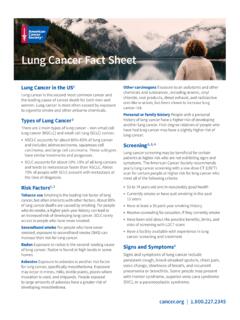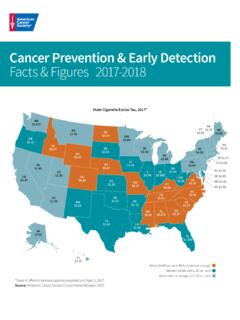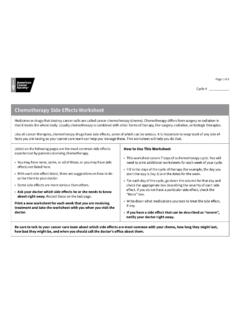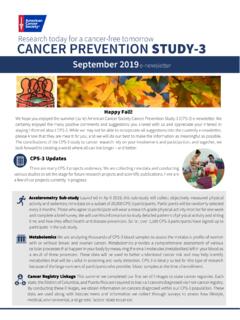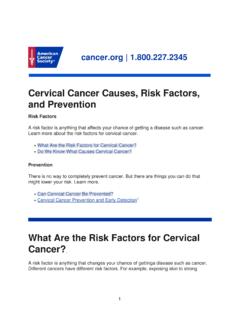Transcription of Bone Cancer Early Detection, Diagnosis, and Staging
1 Bone Cancer Early Detection, Diagnosis, and Staging | and DiagnosisFinding Cancer Early -- while it's small and before it has spread -- often allows for moretreatment options. Some Early cancers may have signs and symptoms that can benoticed, but that's not always the Bone Cancer Be Found Early ?lSigns and Symptoms of Bone CancerlTests for Bone CancerlStages and Outlook (Prognosis)After a Cancer diagnosis, Staging provides important information about the extent ofcancer in the body and anticipated response to Cancer StageslSurvival Rates for Bone CancerlQuestions to Ask About Bone CancerHere are some questions you can ask your Cancer care team to help you betterunderstand your Cancer diagnosis and treatment to Ask About Bone Cancerl1 american Cancer | Bone Cancer Be Found Early ? The information here focuses on primary bone cancers (cancers that start in bones) thatmost often are seen in adults.
2 Information on Osteosarcoma1, Ewing Tumors2 (Ewingsarcomas), and Bone Metastasis3 is covered this time, there are no widely recommended screening tests for bone Cancer inpeople who aren t known to be at increased risk. (Screening is testing for Cancer inpeople without any symptoms.)Still, most bone cancers are found at an Early stage, before they have clearly spread toother parts of the body. Symptoms such as bone pain or swelling often prompt a visit toa doctor. (For more on this, see Signs and Symptoms of Bone Cancer .)For people at higher riskFor some people who are at increased risk for bone Cancer because they have certainbone conditions (listed in Risk Factors for Bone Cancer4), doctors might recommendcloser monitoring. Watching for Early signs and symptoms can sometimes be helpful infinding bone Cancer Early and treating it ME, Dubois SG, Gebhart MC.
3 Chapter 89: Sarcomas of bone. In:Niederhuber JE, Armitage JO, Doroshow JH, Kastan MB, Tepper JE, eds. Abeloff sClinical Oncology. 6th ed. Philadelphia, Pa: Elsevier; Revised: June 17, 20212 american Cancer | and Symptoms of Bone Cancer The information here focuses on primary bone cancers (cancers that start in bones) thatmost often are seen in adults. Information on Osteosarcoma,1 Ewing Tumors2 (Ewingsarcomas), and Bone Metastasis3 is covered are different types of primary bone cancer4. Signs and symptoms depend mainlyon the type, location, and extent of the in the area of the tumor is the most common sign of bone Cancer . At first, the painmight not be there all the time. It may get worse at night or when the bone is used, suchas when walking for a tumor in a leg bone. Over time, the pain can become moreconstant, and it might get worse with a tumor can weaken a bone to the point where it breaks (fractures), whichcan cause a sudden onset of intense pain (see Fractures below).
4 Lump or swellingSome bone tumors cause a lump or swelling in the area, although this might not happenuntil sometime after the area becomes in the bones of the neck can sometimes cause a lump in the back of the throatthat can lead to trouble swallowing or Cancer can weaken the bone, but most often the bones do not fracture (break).People with a fracture next to or through a bone tumor usually describe sudden severepain in a bone that had been sore for a few symptomsCancer in the bones of the spine can press on the nerves coming out of the spinal can cause numbness and tingling or even weakness in different parts of the body,depending on where the tumor Cancer | Cancer , like many other types of Cancer , can sometimes cause weight loss the Cancer spreads to other organs, it can also cause other symptoms.
5 For instance, ifthe Cancer spreads to the lungs, it might result in a cough or trouble Cancer isn t common, and the symptoms it can cause are more likely to bedue to other conditions, such as injuries or arthritis. Still, if you have symptomsthat go on for a long time or get worse, it s important to see a doctor so the causecan be found and treated, if ME, Dubois SG, Gebhart MC. Chapter 89: Sarcomas of bone. In:Niederhuber JE, Armitage JO, Doroshow JH, Kastan MB, Tepper JE, eds. Abeloff sClinical Oncology. 6th ed. Philadelphia, Pa: Elsevier; FJ, McCarville B, Agaram N. Bone tumors: Diagnosis and biopsy 2020. Accessed at on August 28, Revised: June 17, 2021 Tests for Bone Cancer The information here focuses on primary bone cancers (cancers that start in bones) thatmost often are seen in adults.
6 Information on Osteosarcoma,1 Ewing Tumors2 (Ewing4 american Cancer | ), and Bone Metastasis3 is covered bone cancers are usually found when signs or symptoms a person is havingprompt them to visit a and the results of physical exams and imaging tests might suggest that aperson has bone Cancer . But in most cases, doctors need to confirm this by taking andtesting a tissue or cell sample (a procedure known as a biopsy4).It s important for doctors to distinguish primary bone cancers from cancers that havespread to the bones from other parts of the body (bone metastasis5), as well as frombone tumors that are benign (not Cancer ) and from other types of bone problems. Theseconditions might need different types of diagnosis of a bone tumor often depends on combining informationabout which bone and what part of the bone is affected, how it looks on imagingtests, and what the tumor cells look like under a a bone Cancer is found, other tests might then be needed to learn more about history and physical examIf a person has signs or symptoms that suggest they might have a bone tumor, thedoctor will want to take a complete medical history to find out more about physical exam can sometimes provide information about a possible tumor.
7 Forexample, the doctor may be able to see or feel an abnormal doctor may also look for problems in other parts of the body. When adults havecancer in the bones, it s most often the result of Cancer that started somewhere elseand then spread to the bones (bone metastasis).After the exam, if the doctor suspects it could be bone Cancer (or another type of bonetumor), more tests will be done. These might include imaging tests, biopsies, and/or testsImaging tests use x-rays, magnetic fields, or radioactive substances to create picturesof the inside of the body. Imaging tests might be done for a number of reasons,5 american Cancer | :To help find out if a suspicious area might be cancerlTo help determine if a Cancer might have started in another part of the bodylTo learn how far Cancer has spreadlTo help determine if treatment is workinglTo look for signs that the Cancer might have come backlPeople who have or might have bone Cancer will have one or more of these tests.
8 Formore information on these tests, see Imaging (Radiology) Tests for x-ray7 of the bone is often the first test done if some type of bone tumor issuspected. Tumors might look ragged instead of solid on an x-ray, or they might looklike a hole in the bone. Sometimes doctors can see a tumor that might extend intonearby tissues (such as muscle or fat).Doctors might strongly suspect an abnormal area is a bone Cancer by the way itappears on an x-ray, but usually a biopsy (described below) is needed to tell for with bone tumors might have a chest x-ray done to see if the Cancer has spreadto the lungs. But this test isn't needed if a chest CT scan (discussed below) has resonance imaging (MRI)MRI scans8 create detailed images of the inside of the body using radio waves andstrong magnets instead of x-rays, so no radiation is involved.
9 A contrast material calledgadoliniumis often injected into a vein before the scan to better see MRI is often done to get a more detailed look at an abnormal area of bone seen onan x-ray. MRIs can usually show if it s likely to be a tumor, an infection, or some type ofbone damage from another can help determine the exact extent of a tumor, as they can show the marrowinside bones and the soft tissues around the tumor, including nearby blood vessels andnerves. MRIs can also show any small bone tumors several inches away from the maintumor (called skip metastases). Knowing the extent of tumor is very important whenplanning Cancer | tomography (CT) scanA CT scan9 combines many x-ray pictures to make detailed cross-sectional images ofparts of the body. CT scans aren t usually as helpful as MRIs in showing the detail in and around bonetumors.
10 But they are often done to look for possible Cancer spread in other parts of thebody, such as the lungs, liver, or other scans can also be used to guide a biopsy needle into a tumor (a CT-guided needlebiopsy). For this test, you stay on the CT scanning table while the doctor moves abiopsy needle toward the tumor. CT scans are repeated until the tip of the needle iswithin the mass. (See Needle biopsy below.)Bone scanA bone scan10 can show if a Cancer has spread to other bones, and is often part of theworkup for people with bone Cancer . This test is useful because it can show the entireskeleton at once. A positron emission tomography (PET) scan, described below, canoften provide similar information, so a bone scan might not be needed if a PET scan this test, a small amount of low-level radioactive material is injected into the bloodand travels to the bones.

